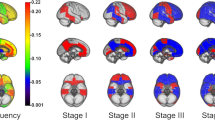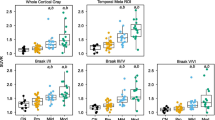Abstract
Purpose
Similar regional anatomical distributions were reported for fibrillary amyloid deposition [measured by 11C-Pittsburgh compound B (PIB) positron emission tomography (PET)] and brain hypometabolism [measured by 18F-fluorodeoxyglucose (FDG) PET] in numerous Alzheimer’s disease (AD) studies. However, there is a lack of longitudinal studies evaluating the interrelationships of these two different pathological markers in the same AD population. Our most recent AD study suggested that the longitudinal pattern of hypometabolism anatomically follows the pattern of amyloid deposition with temporal delay, which indicates that neuronal dysfunction may spread within the anatomical pattern of amyloid pathology. Based on this finding we now hypothesize that in early AD patients quantitative longitudinal decline in hypometabolism may be related to the amount of baseline amyloid deposition during a follow-up period of 2 years.
Methods
Fifteen patients with mild probable AD underwent baseline (T1) and follow-up (T2) examination after 24 ± 2.1 months with [18F]FDG PET, [11C]PIB PET, structural T1-weighted MRI and neuropsychological testing [Consortium to Establish a Registry for Alzheimer's Disease (CERAD) neuropsychological battery]. Longitudinal cognitive measures and quantitative PET measures of amyloid deposition and metabolism [standardized uptake value ratios (SUVRs)] were obtained using volume of interest (VOI)-based approaches in the frontal-lateral-retrosplenial (FLR) network and in predefined bihemispheric brain regions after partial volume effect (PVE) correction of PET data. Statistical group comparisons (SUVRs and cognitive measures) between patients and 15 well-matched elderly controls who had undergone identical imaging procedures once as well as Pearson’s correlation analyses within patients were performed.
Results
Group comparison revealed significant cognitive decline and increased mean PIB/decreased FDG SUVRs in the FLR network as well as in several AD-typical regions in patients relative to controls. Concurrent with cognitive decline patients showed longitudinal increase in mean PIB/decrease in mean FDG SUVRs over time in the FLR network and in several AD-typical brain regions. Correlation analyses of FLR network SUVRs in patients revealed significant positive correlations between PIB T1 and delta FDG (FDG T1-T2) SUVRs, between PIB T1 and PIB T2 SUVRs, between FDG T1 and PIB T2 SUVRs as well as between FDG T1 and FDG T2 SUVRs, while significant negative correlations were found between FDG T1 and delta PIB (PIB T1-T2) SUVRs as well as between FDG T2 and delta FDG (FDG T1-T2) SUVRs. These findings were confirmed in locoregional correlation analyses, revealing significant associations in the same directions for two left hemispheric regions and nine right hemispheric regions, showing the strongest association for bilateral precuneus.
Conclusion
Baseline amyloid deposition in patients with mild probable AD was associated with longitudinal metabolic decline. Additionally, mildly decreased/relatively preserved baseline metabolism was associated with a longitudinal increase in amyloid deposition. The latter bidirectional associations were present in the whole AD-typical FLR network and in several highly interconnected hub regions (i.e. in the precuneus). Our longitudinal findings point to a bidirectional quantitative interrelationship of the two investigated AD pathologies, comprising an initial relative maintenance of neuronal activity in already amyloid-positive hub regions (neuronal compensation), followed by accelerated amyloid deposition, accompanied by functional neuronal decline (neuronal breakdown) along with cognitive decline.





Similar content being viewed by others
References
Braak H, Braak E. Neuropathological staging of Alzheimer-related changes. Acta Neuropathol 1991;82:239–59.
Braak H, Braak E. Diagnostic criteria for neuropathologic assessment of Alzheimer’s disease. Neurobiol Aging 1997;18:S85–8.
Förster S, Buschert VC, Buchholz HG, Teipel SJ, Friese U, Zach C, et al. Effects of a 6-month cognitive intervention program on brain metabolism in amnestic mild cognitive impairment and mild Alzheimer’s disease. J Alzheimers Dis 2011;25:695–706. doi:10.3233/JAD-2011-100996.
Förster S, Grimmer T, Miederer I, Henriksen G, Yousefi BH, Graner P, et al. Regional expansion of hypometabolism in Alzheimer’s disease follows amyloid deposition with temporal delay. Biol Psychiatry 2012;71:792–7. doi:10.1016/j.biopsych.2011.04.023.
Alexander GE, Chen K, Pietrini P, Rapoport SI, Reiman EM. Longitudinal PET evaluation of cerebral metabolic decline in dementia: a potential outcome measure in Alzheimer’s disease treatment studies. Am J Psychiatry 2002;159:738–45.
Förster S, Teipel S, Zach C, Rominger A, Cumming P, Fougere CL, et al. FDG-PET mapping the brain substrates of visuo-constructive processing in Alzheimer’s disease. J Psychiatr Res 2010;44:462–9. doi:10.1016/j.jpsychires.2009.09.012.
Förster S, Vaitl A, Teipel SJ, Yakushev I, Mustafa M, la Fougère C, et al. Functional representation of olfactory impairment in early Alzheimer’s disease. J Alzheimers Dis 2010;22:581–91. doi:10.3233/JAD-2010-091549.
Klunk WE, Engler H, Nordberg A, Wang Y, Blomqvist G, Holt DP, et al. Imaging brain amyloid in Alzheimer’s disease with Pittsburgh Compound-B. Ann Neurol 2004;55:306–19. doi:10.1002/ana.20009.
Drzezga A, Grimmer T, Henriksen G, Mühlau M, Perneczky R, Miederer I, et al. Effect of APOE genotype on amyloid plaque load and gray matter volume in Alzheimer disease. Neurology 2009;72:1487–94. doi:10.1212/WNL.0b013e3181a2e8d0.
Grimmer T, Riemenschneider M, Förstl H, Henriksen G, Klunk WE, Mathis CA, et al. Beta amyloid in Alzheimer’s disease: increased deposition in brain is reflected in reduced concentration in cerebrospinal fluid. Biol Psychiatry 2009;65:927–34. doi:10.1016/j.biopsych.2009.01.027.
Jack Jr CR, Lowe VJ, Weigand SD, Wiste HJ, Senjem ML, Knopman DS, et al. Serial PIB and MRI in normal, mild cognitive impairment and Alzheimer’s disease: implications for sequence of pathological events in Alzheimer’s disease. Brain 2009;132:1355–65. doi:10.1093/brain/awp062.
Scheinin NM, Aalto S, Koikkalainen J, Lötjönen J, Karrasch M, Kemppainen N, et al. Follow-up of [11C]PIB uptake and brain volume in patients with Alzheimer disease and controls. Neurology 2009;73:1186–92. doi:10.1212/WNL.0b013e3181bacf1b.
Kadir A, Almkvist O, Forsberg A, Wall A, Engler H, Långström B, et al. Dynamic changes in PET amyloid and FDG imaging at different stages of Alzheimer’s disease. Neurobiol Aging 2012;33:198.e1–14. doi:10.1016/j.neurobiolaging.2010.06.015.
Engler H, Forsberg A, Almkvist O, Blomquist G, Larsson E, Savitcheva I, et al. Two-year follow-up of amyloid deposition in patients with Alzheimer’s disease. Brain 2006;129:2856–66. doi:10.1093/brain/awl178.
Villemagne VL, Pike KE, Chételat G, Ellis KA, Mulligan RS, Bourgeat P, et al. Longitudinal assessment of Aβ and cognition in aging and Alzheimer disease. Ann Neurol 2011;69:181–92. doi:10.1002/ana.22248.
Cohen AD, Price JC, Weissfeld LA, James J, Rosario BL, Bi W, et al. Basal cerebral metabolism may modulate the cognitive effects of Abeta in mild cognitive impairment: an example of brain reserve. J Neurosci 2009;29:14770–8. doi:10.1523/JNEUROSCI.3669-09.2009.
McKhann G, Drachman D, Folstein M, Katzman R, Price D, Stadlan EM. Clinical diagnosis of Alzheimer’s disease: report of the NINCDS-ADRDA Work Group under the auspices of Department of Health and Human Services Task Force on Alzheimer’s Disease. Neurology 1984;34:939–44.
Drzezga A, Grimmer T, Henriksen G, Stangier I, Perneczky R, Diehl-Schmid J, et al. Imaging of amyloid plaques and cerebral glucose metabolism in semantic dementia and Alzheimer’s disease. Neuroimage 2008;39:619–33. doi:10.1016/j.neuroimage.2007.09.020.
Ziolko SK, Weissfeld LA, Klunk WE, Mathis CA, Hoge JA, Lopresti BJ, et al. Evaluation of voxel-based methods for the statistical analysis of PIB PET amyloid imaging studies in Alzheimer’s disease. Neuroimage 2006;33:94–102. doi:10.1016/j.neuroimage.2006.05.063.
Hedden T, Van Dijk KR, Becker JA, Mehta A, Sperling RA, Johnson KA, et al. Disruption of functional connectivity in clinically normal older adults harboring amyloid burden. J Neurosci 2009;29:12686–94. doi:10.1523/JNEUROSCI.3189-09.2009.
Drzezga A, Becker JA, Van Dijk KR, Sreenivasan A, Talukdar T, Sullivan C, et al. Neuronal dysfunction and disconnection of cortical hubs in non-demented subjects with elevated amyloid burden. Brain 2011;134:1635–46. doi:10.1093/brain/awr066.
Desikan RS, Ségonne F, Fischl B, Quinn BT, Dickerson BC, Blacker D, et al. An automated labeling system for subdividing the human cerebral cortex on MRI scans into gyral based regions of interest. Neuroimage 2006;31:968–80. doi:10.1016/j.neuroimage.2006.01.021.
Buckner RL, Snyder AZ, Shannon BJ, LaRossa G, Sachs R, Fotenos AF, et al. Molecular, structural, and functional characterization of Alzheimer’s disease: evidence for a relationship between default activity, amyloid, and memory. J Neurosci 2005;25:7709–17. doi:10.1523/JNEUROSCI.2177-05.2005.
Buckner RL, Andrews-Hanna JR, Schacter DL. The brain’s default network: anatomy, function, and relevance to disease. Ann N Y Acad Sci 2008;1124:1–38. doi:10.1196/annals.1440.011.
Kamenetz F, Tomita T, Hsieh H, Seabrook G, Borchelt D, Iwatsubo T, et al. APP processing and synaptic function. Neuron 2003;37:925–37.
Cirrito JR, Yamada KA, Finn MB, Sloviter RS, Bales KR, May PC, et al. Synaptic activity regulates interstitial fluid amyloid-beta levels in vivo. Neuron 2005;48:913–22. doi:10.1016/j.neuron.2005.10.028.
Greicius MD, Srivastava G, Reiss AL, Menon V. Default-mode network activity distinguishes Alzheimer’s disease from healthy aging: evidence from functional MRI. Proc Natl Acad Sci U S A 2004;101:4637–42. doi:10.1073/pnas.0308627101.
Landau SM, Harvey D, Madison CM, Koeppe RA, Reiman EM, Foster NL, et al. Associations between cognitive, functional, and FDG-PET measures of decline in AD and MCI. Neurobiol Aging 2011;32:1207–18. doi:10.1016/j.neurobiolaging.2009.07.002.
Edison P, Archer HA, Hinz R, Hammers A, Pavese N, Tai YF, et al. Amyloid, hypometabolism, and cognition in Alzheimer disease: an [11C]PIB and [18F]FDG PET study. Neurology 2007;68:501–8. doi:10.1212/01.wnl.0000244749.20056.d4.
Ng S, Villemagne VL, Berlangieri S, Lee ST, Cherk M, Gong SJ, et al. Visual assessment versus quantitative assessment of 11C-PIB PET and 18F-FDG PET for detection of Alzheimer’s disease. J Nucl Med 2007;48:547–52.
Grimmer T, Tholen S, Yousefi BH, Alexopoulos P, Förschler A, Förstl H, et al. Progression of cerebral amyloid load is associated with the apolipoprotein E ε4 genotype in Alzheimer’s disease. Biol Psychiatry 2010;68:879–84. doi:10.1016/j.biopsych.2010.05.013.
Tosun D, Schuff N, Mathis CA, Jagust W, Weiner MW, Alzheimer’s Disease Neuroimaging Initiative. Spatial patterns of brain amyloid-beta burden and atrophy rate associations in mild cognitive impairment. Brain 2011;134:1077–88. doi:10.1093/brain/awr044.
Villain N, Fouquet M, Baron JC, Mézenge F, Landeau B, de La Sayette V, et al. Sequential relationships between grey matter and white matter atrophy and brain metabolic abnormalities in early Alzheimer’s disease. Brain 2010;133:3301–14. doi:10.1093/brain/awq203.
Chételat G, Desgranges B, Landeau B, Mézenge F, Poline JB, de la Sayette V, et al. Direct voxel-based comparison between grey matter hypometabolism and atrophy in Alzheimer’s disease. Brain 2008;131:60–71. doi:10.1093/brain/awm288.
Gouw AA, Seewann A, Vrenken H, van der Flier WM, Rozemuller JM, Barkhof F, et al. Heterogeneity of white matter hyperintensities in Alzheimer’s disease: post-mortem quantitative MRI and neuropathology. Brain 2008;131:3286–98. doi:10.1093/brain/awn265.
Mosconi L, Pupi A, De Leon MJ. Brain glucose hypometabolism and oxidative stress in preclinical Alzheimer’s disease. Ann N Y Acad Sci 2008;1147:180–95. doi:10.1196/annals.1427.007.
Bai F, Zhang Z, Watson DR, Yu H, Shi Y, Yuan Y. Abnormal white matter independent of hippocampal atrophy in amnestic type mild cognitive impairment. Neurosci Lett 2009;462:147–51. doi:10.1016/j.neulet.2009.07.009.
Selkoe DJ. Alzheimer’s disease is a synaptic failure. Science 2002;298:789–91. doi:10.1126/science.1074069298/5594/789.
Wei W, Nguyen LN, Kessels HW, Hagiwara H, Sisodia S, Malinow R. Amyloid beta from axons and dendrites reduces local spine number and plasticity. Nat Neurosci 2010;13:190–6. doi:10.1038/nn.2476.
Ingelsson M, Fukumoto H, Newell KL, Growdon JH, Hedley-Whyte ET, Frosch MP, et al. Early Abeta accumulation and progressive synaptic loss, gliosis, and tangle formation in AD brain. Neurology 2004;62:925–31.
Conflicts of interest
None.
Author information
Authors and Affiliations
Corresponding author
Rights and permissions
About this article
Cite this article
Förster, S., Yousefi, B.H., Wester, HJ. et al. Quantitative longitudinal interrelationships between brain metabolism and amyloid deposition during a 2-year follow-up in patients with early Alzheimer’s disease. Eur J Nucl Med Mol Imaging 39, 1927–1936 (2012). https://doi.org/10.1007/s00259-012-2230-9
Received:
Accepted:
Published:
Issue Date:
DOI: https://doi.org/10.1007/s00259-012-2230-9




